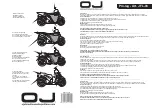
8. Frame, Fork, and
Seat
9. Motor Drive
Assembly and
Thro�le
10. Ba�ery
11. Electrical Cables
Check that the frame and fork are not bent or broken.
If either frame or fork are bent or broken, they should be replaced.
Check that the seat is adjusted properly, and seatpost quick release lever is securely �ghtened.
Ensure hub motor is spinning smoothly and motor bearings are in good working order.
Ensure all power cables running to hub motor are secured and undamaged.
Make sure the hub motor axle bolts are secured and the torque arm, torque arm bolt, and torque
washers are in place.
Ensure ba�ery is charged before use.
Ensure there is no damage to ba�ery.
Lock ba�ery to frame and ensure that it is secured.
Charge and store bike and ba�ery in a dry loca�on, between 50 °F – 77 °F (10 °C – 25 °C).
Let bike dry completely before using again.
Look over connectors to make sure they are fully seated and free from debris or moisture.
Check cables and cable housing for obvious signs of damage.
Ensure headlight, taillight, and brake light are func�oning, adjusted properly, and unobstructed.
12. Accessories
Ensure all reflectors are properly fi�ed and not obscured.
Ensure all other fi�ngs on bike are properly secured and func�oning.
Inspect helmet and other safety gear for signs of damage.
Ensure rider is wearing a helmet and other required riding safety gear.
Ensure moun�ng hardware is properly secured if fi�ed with a front rack, rear rack, basket, etc.
Ensure the taillight and taillight power wire are properly secured if fi�ed with rear rack.
Ensure the fender moun�ng hardware is properly secured if fi�ed with fenders.
Ensure there are no cracks or holes in fenders.
If installed, ensure the op�onal rear wheel lock is secured in the unlocked posi�on and the key is
removed before every ride.
Your cables, spokes, and chain will stretch after an initial break-in period of 50-100 mi
(80-160 km), and bolted connections can loosen. Always have a certified, reputable bike
mechanic perform a tune-up on your bike after your initial break-in period of 50-100 mi
(80-160 km) (depending on riding conditions such as total weight, riding characteristics,
and terrain). Regular inspections and tune-ups are particularly important for ensuring that
your bike remains safe and fun to ride.
Safety Check
Tire Inflation and Replacement
The Race employs 26"×1.95"rubber �res with inner tubes. The �res are designed for durability and safety for regular cycling
ac�vi�es and need to be checked before each use for proper infla�on and condi�on. Proper infla�on, care, and �mely
replacement will help ensure that your bike’s opera�onal characteris�cs will be maintained, and unsafe condi�ons avoided.
Even �res equipped with built-in, flat-preventa�ve �re liners, like those that come with bikes from heybike, can and do get flats
from punctures, pinches, impact, and other causes. When �re wear becomes evident or a flat �re is discovered, �res and/or
tubes must be replaced before opera�ng the bike or injury to operators and/or damage to your bike from heybike could occur.
For more informa�on on �re or tube replacement procedures, or ques�ons about �re infla�on, visit
heybike.com/pages/help-center or contact heybike Product Support.
Email: [email protected]
heybike recommends
45-60 PSI
for the stock �res on the heybike. Always stay within the manufacturer’s recommended air
pressure range as listed on the �re sidewall.
It is critically important that proper air pressure is always maintained in pneumatic tires. Do not underinflate or overinflate your
tires. Low pressure may result in loss of control, and overinflated tires may burst. Failure to always maintain the air pressure
rating indicated on pneumatic tires may result in tire and/or wheel failure.
When changing a tire or tube, ensure that all air pressure has been removed from the inner tube prior to removing the tire from
the rim. Failure to remove all air pressure from the inner tube could result in serious injury.
Using aftermarket tires or inner tubes, not provided by heybike may void your warranty, create an unsafe riding
condition, or damage to your bike. If required by law, ensure replacement aftermarket tires have sufficient reflective sidewall
striping.
Inflate your tires from a regulated air source with an available pressure gauge. Inflating your tires from an unregulated air source
could overinflate them, resulting in a burst tire.
26
27
Summary of Contents for Race 26
Page 12: ...21 20...





































